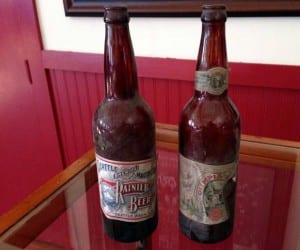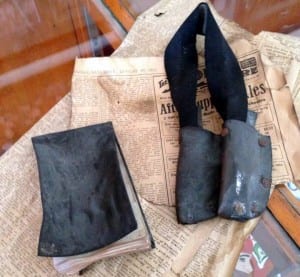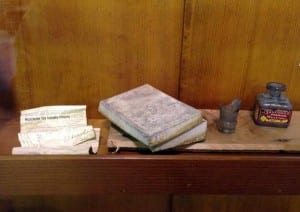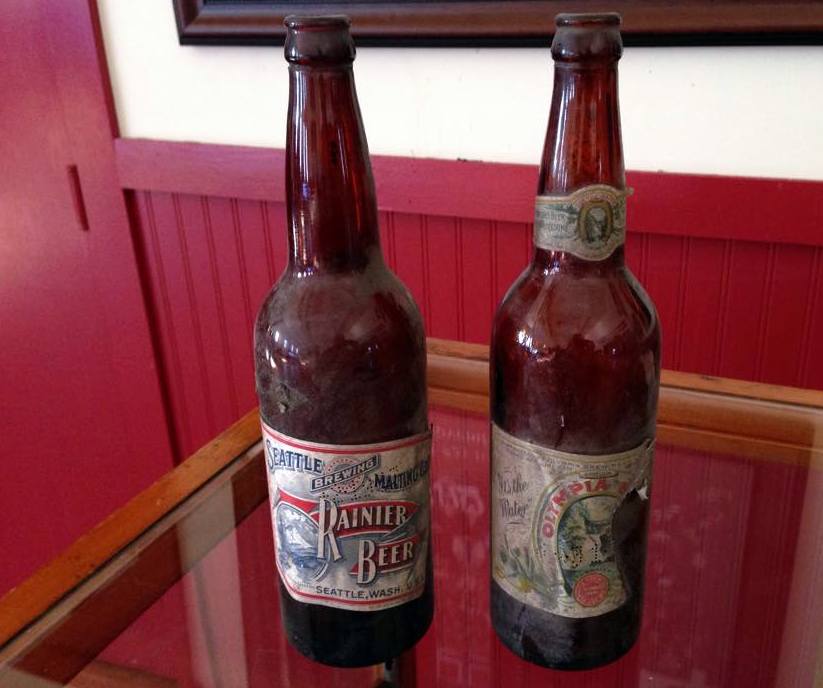
These beer bottles were found in the walls of the Sons of Norway during remodeling. The labels are dated 1906. Photo courtesy of Jill Williams
Petersburg’s Sons of Norway hall looks kind of like a big barn on the town’s main waterfront. It’s two stories, white with a red roof and trim and traditional flowery rose mauling designs on the window frames. It was built in 1912 one year after the local lodge was formed as part of the international nonprofit Sons of Norway. To this day, the hall remains Petersburg’s largest gathering place.
To resident Jill Williams, the building embodies a culture from a different era.
“Our town had like an orchestra, they had bands. The Sons of Norway, when they first opened, they were having dances every week…every week,” Williams said. “It was a way of socializing. Back then, they didn’t have radios, they didn’t have TV, you know, they got out and socialized.”
Williams has been a member of Petersburg’s Sons of Norway lodge for over 40 years. Her grandparents came from Norway. So when she found out that the carpenters working on the hall had found artifacts in the walls and floor she was pretty excited.
The lodge has been slowly remodeling the historic building since this spring. And in the process, construction workers found a rough cut board with Norwegian writing on it, an old inkwell, and a few empty beer bottles with labels from 1906.
“And look how beautiful they are,” Williams said. “I lightly dusted it, I didn’t want to take all the grime off.”
The new artifacts are now on display in a glass case near the hall’s entrance. Williams told me about each one.

A leather bound notebook and knife holder under the floor of the men’s bathroom upstairs. Photo courtesy of Jill Williams
Williams: “So the first thing found was the board and then they called me and told me that they found two beer bottles. So I got really excited about that too and ran down and sure enough… two big beer bottles, like the size of a wine bottle.”
Denning: “Yeah, they’re not the beer bottles of today.”
Williams: “No, and very heavy. And what was really cool is one has a Ranier label and the other one has an Olympia label. And 1906 labels. They’re in our display case.”
Denning: “So, they were in the walls of the hall?”
Williams: “The beer bottles were found–we’ll walk up there–but it’s up the staircase facing the water. They were in the walls, inside the wall, like they had just drank their beer and then dropped it down in the walls and closed up the wall.”
Denning: “Lucky they did that for everyone now.”
Williams: “Well, and I’m thinking there’s probably more treasures in the walls that haven’t been found. And I told the carpenters, you know, before you close up these walls you guys probably need to drop a few things in there for the next hundred years. . . .and then under the men’s bathroom upstairs they found part of an old newspaper. It looks like they tore it out kind of for a reason, for us to find it. It’s August 1911, a Tacoma paper. . . .and then there’s a little strap with a couple of leather like knife holders that I think probably went over their belt, their tool belt. That was found there and this little booklet. . . there wasn’t much writing in that.
Denning: “Looks like a leather bound little black note pad of some sort. Like a little cheap notepad we’d have today except its leather bound.”
Williams: “And kind of warped probably from all the dampness. And then one more find was a dead space behind the women’s bathroom upstairs, they found this inkwell.”
The found objects are extra special because the lodge had lost some of its history in a fire. The group has stored documents in a general store next to the hall which burned to the ground in 1919.

The inkwell and other items were found in a space behind the women’s bathroom upstairs at the Sons of Norway Hall. Photo courtesy of Jill Williams
But it’s not just about the objects themselves. It’s about the people who used them. The person who wrote on the board in 1912 was named Hans Wick (pronounced Vick). Through research Williams found that Wick had come to Petersburg in 1908 and quickly became an involved community member. He was the town Marshall, the fire chief, the health officer, and the superintendent of public works.
So what did he write on the board?
“Well, everybody will have to interpret this as they see fit,” Williams said. “So this is what old Hans wrote in Norwegian translated into English: ‘As you mess around in a couple of bunks, you’ll get the answer says the old Hans’.”
The meaning of Hans Wick’s message might never be known but that’s okay with Williams. She’s fine with just appreciating the new artifacts as a link to the town’s Norwegian history.












